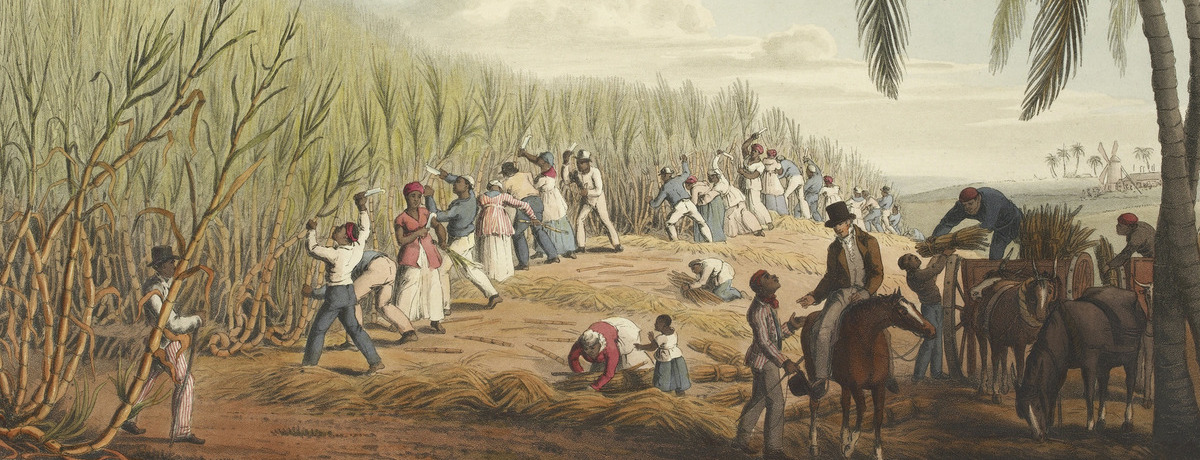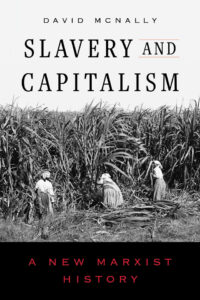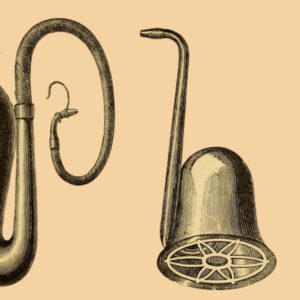
Inside the Political Economy of New World Slavery
David McNally Offers a Marxist Perspective on the Economics of Human Exploitation
The “primary purpose” of New World slaves, Sidney Mintz wrote,
was to serve as manual laborers engaged…in the production of market commodities…Slaves were not primarily a source of prestige, of sexual satisfaction, of sadistic impulses, or of anything else but profit, and profit in a frankly capitalistic system, even though the curious view that slavery and capitalism are mutually exclusive still persists…These were no serfs toiling on isolated manors, no captives of war endowing their masters with prestige, but industrial workers whose work was principally agricultural…in both their status and their economic function, they resembled the proletarians of Europe more than is often conceded.
This is correct on all counts. Plantation slavery was above all a machinery for the production of profits. Appropriation of surplus labor, objectified in commodities, drove the system. To be sure, the drive to appropriate was often bound up with sadism and love of domination. But the law of plantation reproduction revolved around profit.
Planters themselves had no doubts as to the profits to be made from bonded laborers. Early on, they were calculating revenue earned “per hand.” Samuel Hartlib in 1655 estimated that planters on average accrued an income of £14 per bonded worker in tobacco cultivation. More than a century later, Scotsman James Grant carefully deducted yearly costs of slave purchase and maintenance from output per head in claiming that planters on a “well established” estate could expect an annual profit of £8 per enslaved worker. While these estimates were at best rough and ready, they reveal the focus on costs and profits that defined plantation accounting.
What regulated actual Southern credit markets, when bondpeople were used as collateral for loans, were surpluses from slave labor, not short-term fluctuations in slave prices.
Historians have rightly consulted planter account books for evidence regarding rates of return for New World plantations. As vital as this evidence can be, these records tend to systematically underestimate the output of enslaved laborers in recording the production and sale of primary cash crops. Not only were secondary crops generally ignored, so were significant expenditures of enslaved labor in building barns, mending fences, digging canals, spinning, weaving, cooking meals, fishing, cutting timber, and so on. These labors are generally absent from estate accounts, though often evident in diaries. Notwithstanding these limits, data derived from slaveowner records overwhelmingly demonstrate the profitability of New World plantations.
In the case of Barbadian sugar estates in the seventeenth century, Russell Menard has derived average rates of return of 7 to 8 percent annually. Analyzing the Caribbean as a whole, Michael Craton posits plantation rates of return in excess of 10 percent for the first three-quarters of the eighteenth century, followed by modest declines across the last quarter. Richard Follett finds profits ranging between 6 and 12 percent in Louisiana sugar planting in the four decades after 1820, not terribly out of line with David O. Whitten’s estimate of just under 10 percent per year from 1850 to 1860. Drawing on records for the US Lower South (Georgia, South Carolina, and Florida) between 1768 and 1810, Joyce Chaplin suggests rates of return on planter investment ranging from 8 to over 37 percent.
Taking a single Georgia rice plantation from 1835 to 1847, William Dusinberre documents annual returns of 15 percent, falling to a healthy average of 9 percent across the 1850s. Even when profits were declining on South Carolina and Georgia rice plantations in the years before the Civil War, the largest and most productive estates still garnered returns above 6 percent. Similarly, middle- and large-size cotton planters in Texas reaped returns on investment of 6 percent or better across the 1850s and 1860s. All of this is consistent with the study by J. R. Ward that documented an average profit rate of 10 percent for the British West Indies as a whole over eighty-five years (1749-1834).
As we would expect, rates were typically higher on the biggest estates. For instance, analyzing two large sugar plantations in Saint Domingue during the last quarter of the eighteenth century, Gabriel Debien calculated a rate of return of about 12 percent. In 1773, Henry Laurens, one of the wealthiest and most innovative South Carolina planters, reaped an average return of 15 percent from his many estates. Texas planters with between 20 and 49 bondpeople saw profit rates of 6.5 percent in 1850 and just under 10 percent in 1860. Those employing more than 50 chattel laborers enjoyed considerably higher returns: over 9 percent in 1850 and more than 12 percent a decade later. Profits made on renting out enslaved people reinforce these estimates.
Robert Evans found that masters who leased out male slaves in the antebellum South made annual profits between 9 and 17 percent. He suggested, not unreasonably, that the profit rate on rental of bondpeople should be close to that derived from their direct employment. Working with a larger data base, Klas Rönnbäck proposes an average profit rate of 14 to 15 percent for Southern slaveowners who rented out bondpeople. This is undoubtedly too high, as Rönnbäck incorrectly merges potential “capital gains” from appreciation of slave prices with the surplus product (or “net rent”) they generated. Deflating Rönnbäck’s estimates appropriately gives a real rate of return of between 9 and 11 percent annually.
If we turn to the returns on industrial enterprises fueled by slave labor, we find similar patterns with somewhat higher rates of return, albeit over less extensive time periods. Records from textile mills in the antebellum South display average annual profits of about 16 percent.
The renowned Tredegar Iron Works of Richmond, Virginia, reaped profits of 20 percent or better every year from 1844 to 1861. A Louisiana lumber yard earned returns of 12.5 percent and higher between 1846 and 1850.
All of these studies used planter records and accounts of slave-based industrial firms to calculate the surplus of revenue over annual expenses. Extensive data on cotton output, the enslaved population, farm size, and costs of slave maintenance to be derived from the US censuses of 1850 and 1860 also yield useful estimates of the real surplus (in cotton) per bonded worker and per field hand. That, of course, is what mattered to planters (and industrialists) themselves: whether their incomes from slave output adequately exceeded their costs of production. This real profit rate governed plantation accumulation and the living standards of planter households.
However, mainstream neoclassical economists often disregard the actual profits upon which the planter class lived, which they characterize as merely an accountant’s profit rate. Mesmerized by hypothetical models of the plantation economy that satisfy their assumptions about general equilibrium and perfectly competitive prices, they often gravitate to data on slave prices—not the output of enslaved laborers—for model-building exercises. While it is true that slave prices did rise consistently (albeit quite unevenly) across the history of the plantation system, for reasons which I shall clarify below, to focus on this is a version of price fetishism. What regulated actual Southern credit markets, when bondpeople were used as collateral for loans, were surpluses from slave labor, not short-term fluctuations in slave prices. As one detailed survey of antebellum Louisiana showed, “lending practices were influenced primarily by income streams [from slave labor—DM], not rising asset values.”
To focus on the “asset values” of slaves is to substitute the prices of bondpeople for the value of what they produced. It is to treat them as simple commodities rather than as commodity producers, that is, living laborers. In assessing plantation profits based on appreciation of slave prices, neoclassicists tend to reify bonded laborers themselves—literally thingify them—by treating them as units of capital whose market values are what determine profit or loss. The productive powers of bonded laborers—the fact that they expend living labor to create value and surplus value—are annulled via the attribution of labor’s creative powers to capital.
In Marx’s terminology, this is a form of capital fetishism. Just as commodities are fetishized as if their values resided in them as things rather than as products of living labor, so the material elements of capital (machines, land, tools, money) are mystified as if they had the magical ability to generate more capital out of themselves, rather than through their interaction with living labor. Commodity and capital fetishism, with their attribution of labor’s powers to things, are reproduced by mainstream economics, for which, as Marx observed, “all the social productive forces of labour appear as the productive forces of capital, as intrinsic attributes of capital.” The fatal error of bourgeois economists is to “emphasize the objective elements of production and overestimate their importance as against the subjective element, living, immediate labour.”
Marx’s critical theory hinges on defetishizing commodities and capital—on disclosing the ways in which the latter are in fact products of human labor. Ironically, however, a series of ostensibly Marxist interventions into the political economy of plantation slavery have succumbed to fetishism, most egregiously so when commentators insist that enslaved laborers comprised constant capital.
The claim that slaves were “constant capital” is of Weberian provenance, having been first formulated along such lines by Douglas Hall. In his valuable study of slavery in Martinique, Dale Tomich regrettably invoked Hall in this regard. More recently, the argument that slaves represented constant capital has been advanced by Charles Post in The American Road to Capitalism. But perhaps the most disappointing usage of the claim is found in Nick Nesbitt’s The Price of Slavery: Capitalism and Revolution in the Caribbean, where key Marxist concepts, from labor-power to constant and variable capital, are mishandled.
Nesbitt’s argument is a purely deductive one: If bondpeople were constant capital, and constant capital according to Marx produces no surplus value, it follows that plantation slaves did not produce surplus value. If this is so, then New World slavery could not have been capitalist. Everything hinges, however, on the assertion that bondpeople were constant capital, which appears five times within the first fifty pages of the work. Unfortunately, a mistaken premise generates a wrong conclusion each and every time. In Marx’s terms, enslaved workers actually represent variable capital in the production process. The significance of this distinction is of fundamental importance.
*
In order to clarify what is at stake, it is crucial to grasp the Marxian concepts of labor-power and living labor. Marx frequently links the two terms, as in the following passage: “A portion of the use-value in which capital appears in the process of production is the living labour-power itself.” Living labor, he continues, “is a self-activating capacity, a labour-power that expresses itself purposively.” In purchasing labor-power as a commodity, capitalists claim temporal control over living labor in the process of production. However, because capital appropriates the powers of living labor to itself, the distinctiveness of the latter is deeply obscured. In mainstream economics, living labor is treated as just another “business asset,” one of many inputs into the work process. It is thus conflated with the material “factors” of production, like buildings, land, and machines.
This is the mystification at the heart of the trinity formula in which bourgeois economics conceives of commodities as resulting from the combination of three factors of production: land, labor, and capital. Nonpurposive elements of capital—machines, buildings, land, tools, raw materials—are treated as qualitatively the same as living labor. In this “bewitched and distorted world,” humans are reified; living labor appears as just another thing-like input into the business enterprise. To de-reify, as Marx’s critical theory does, thus requires differentiating “between the objective conditions of labour (the means of production) and its subjective conditions, purposively active capacity for labour, i.e. labour itself.”
As much as labor-power can be exploited, it cannot be entirely appropriated and absorbed by capital—even when the laborer is chattel property.
Let us underline this point. Marx is urging us not to conflate two quite different productive powers mobilized by capital—those of the material means of production and those of living labor (or labor-power in motion). Otherwise, we risk losing sight of the defining properties of labor-power: the creative, purposive, and subjective capabilities of human beings. As we shall see, this conflation also obscures the origin of surplus value. And if we treat laborers as technical factors of production, we also occlude their capacity for resistance and social transformation.
As much as labor-power can be exploited, it cannot be entirely appropriated and absorbed by capital—even when the laborer is chattel property. This is because a living personality always possesses will. This critical insight is embedded in the very definition of labor-power that Marx advances in Capital: “We mean by labour-power, or labour-capacity, the aggregate of those mental and physical capabilities existing in the physical form, the living personality, of a human being.”
This brings us to Marx’s critical distinction between constant capital (konstantes Kapital) and variable capital (variables Kapital). Among other things, Marx is invoking the algebraic distinction between known and invariable (constant) and unknown (variable) values. In Marx’s critique of political economy, this distinction maps onto the division between the objective and subjective factors of production. Whereas constant capital refers to the expenditures capitalists make for material means of production, variable capital refers to their expenses for human labor-power. The latter, of course, is a capacity of humans with wills of their own. And this, as we shall see, is a critical reason why that value is both unknown and variable.
Let us recall that most of the elements that enter a production process—tools, buildings, machines, raw materials—do not produce a surplus value. Their values (and market prices) represent expenditures of past labor. When inserted into the production of new goods, they merely pass on the values they embodied when purchased. Hoes, plows, sewing machines, and computers are products of past labor whose values have been predetermined. The value of such “nonliving” means of production is thus effectively constant across cycles of production. This is what makes these elements of capital “dead labor.” They do not possess the intrinsic potential for growth that inheres in living labor, which can be pushed to create more value than has been expended on it. Rather than merely transmit a predetermined value to commodities, living labor in the capitalist mode of production has the capability to reproduce its own costs and create “new value.”
As dead or past labor, machines, raw materials, tools, and buildings cannot produce more value than entered into their production; none can generate new value, a surplus above their own costs of production. But in purchasing “the living, form-giving fire” that transforms nature and society, capital appropriates a force capable of generating additional value. It follows that the subjective element of capital is variable in the first instance because it generates a value that varies from what is paid for its own upkeep: it produces a surplus value. And this distinction between the living and dead elements of production applies as much to the work of plantation slaves as to that of wage earners.
Bondpeople were not zombies lacking will and subjectivity; they too were living laborers. When planters bought (or rented) slaves, they were making a monetary claim on labor-power, the capacity to generate new value, surplus value. Where wage labor and chattel labor are concerned, “labour-power is, in the one case, sold by himself [the worker—DM], in the other, by a third person.” But in both cases labor-power is sold. With the chattel slave, however, it predominantly involves sale by another, a slaveowner. In both cases, the purchase of labor-power is intended for production of surplus value by means of the production of commodities.
There is yet more to the story. Because they were not zombies, bondpeople nourished capacities for resisting the dictates of capital. And this resistance affected their costs to planters as well as the value of their output. The costs of reproducing living labor varied in response to struggle. A machine, by contrast, costs what it initially cost—and that amount can be amortized over a period of, say, ten years. For accounting purposes, the annual cost does not vary over a ten-year cycle. Not so with laborers. Should workers protest, slow down, or walk off the job for higher rates of pay, this will tend to alter the wage structure (including wages in kind). The historical record overwhelmingly demonstrates, moreover, that enslaved people regularly pressed for improvements in their wages in kind, particularly food and clothing.
Documenting a series of enslaved protests in Berbice for better food and clothes, one historian concludes, “Customary entitlements were inherently unstable and subject to continual renegotiation.” Another commentator, drawing on evidence from neighboring Demerara, observes that “customary practices,” including provision of food and clothing, were the product of “confrontations and implicit negotiations.” Direct action by enslaved workers, even in the face of disciplinary violence, might upset the wage structure, just as their resistance to speed-up or managerial brutality might reduce the surplus product they provided. The costs as well as the value-output of living labor were thus inherently volatile—they were unknowns, or algebraic variables. As much as bondpeople could be sold as capital assets, in the production process they operated as elements of variable capital. But the most compelling evidence that bondpeople were living laborers with wills and subjectivities is found in episodes where they withheld their labor-power.
__________________________________

Reprinted from Slavery and Capitalism: A New Marxist History by David McNally. Copyright © 2025. Courtesy of University of California Press.
David McNally
David McNally is Cullen Distinguished Professor of History and Business at the University of Houston, where he directs the Project on Race and Capitalism. He is the author of seven previous books and more than sixty scholarly articles.












